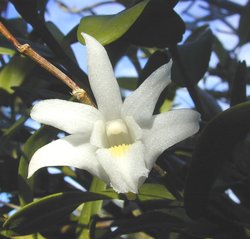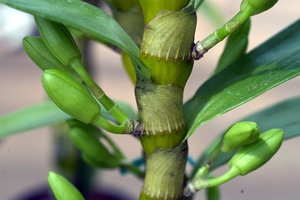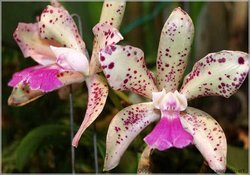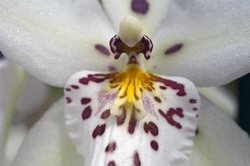Orchidaceae
|
|
| Orchids | ||||||||||
|---|---|---|---|---|---|---|---|---|---|---|
 Orchid | ||||||||||
| Scientific classification | ||||||||||
| ||||||||||
Genera
| ||||||||||
|
Over 800 |
Orchids (Orchidaceae family) are among the largest and most diverse of the flowering plant (angiosperm) families, with over 800 described genera and 25,000 (some sources give 30,000) species, and perhaps another 60,000 hybrids and varieties produced by horticulturalists. The Kew checklist "World Checklist of Orchids" gives about 24,000 accepted names. About 800 new species are added each year. There are more orchid species than all vertebrates combined, excluding bony fishes. Orchids, through their floral complexity and their interactions with pollinators and their symbiosis with mycorrhizae, are considered by some to be the culmination of floral evolution.
Orchids get their name from the Greek orchis, meaning 'testicle', from the appearance of subterranean tuberoids in some terrestrial species. The word 'orchis' was first used by Theophrastos (372/371 - 287/286 BC), in his book "De historia plantarum" (The natural history of plants). He was a student of Aristotle and is considered the father of botany and ecology.
Orchids, in their natural habitat, are considered by CITES as threatened or endangered. They are therefore protected.
| Contents |
General description
These monocotyledonous plants are cosmopolitan in distribution, except Antarctica and deserts. The great majority are to be found in the tropics, mostly Asia, South America and Central America. Orchids can be classified according to the way they retrieve nutrients:
- a majority of species are perennial epiphytes; they are found in tropical moist broadleaf forests or mountains and subtropics. These are anchored on other plants, such as trees, cacti or tree ferns. But they are not parasites.
- others are terrestrial plants, retrieving their nutrients from the soil. This group includes all European orchids.
- a few are lithophytes, growing on rocks, or lack chlorophyll and are saprophytic. These are mycotrophic, i.e. they are completely dependent on their soil fungi for nutrients. A typical example of such a saprophyte is the Bird's-nest Orchid (Neottia nidus-avis).
All orchids have these five basic features :
- the presence of a column
- the flower is bilaterally symmetrical
- the pollen are glued together into the pollinia, a mass of waxy pollen on filaments.
- the seeds are microscopically small, lacking endosperm (food reserves). A notable exception is Disa cardinalis, whose seeds may grow to a length of 1.1 mm
- the seeds can, under natural circumstances, only germinate in symbiosis with specialized fungi. Under artificial circumstances, however, germination is possible "in vitro" on sterile substrates of agar in specialized laboratories.
Leaf
They have simple leaves with lengthwise veins. Their types can be very different; ovate, lanceolate, or orbiculate. The leaves can be enormous or minute, or they can even be lacking (as in the Ghost Orchid (Dendrophylax lindenii). Their size and shape can be an aid in identifying the orchid, since it reflects the taxonomic position.
The structure of the leaves corresponds to the specific habitat of the orchid. Species that typically bask in sunlight, or grow on sites which can be occasionally very dry, have thick, leathery leaves. The laminas are covered by a waxy cuticle. These retain their necessary water supply. Shade species, on the other hand, have tall, thin leaves. They cannot stand a drop in atmospheric humidity or exposure to direct sunlight. Between these two extremes, there is a whole range of intermediate forms.
The leaves of most orchids live on, attached to their pseudobulbs, for several years. Other species, especially those with plicate leaves, shed their aged leaves annually, through an articulation between the lamina and the petiole sheath, and develop new leaves together with new pseudobulbs (as in the genus Catasetum).
The leaves of some species can be most beautiful. The leaves of the Macodes sanderiana, a semiterrestrial or lithophyte, show a sparkling silver and gold veining on a light green background. The cordate leaves of Psychopsiella limminghei are light brownish green with maroon-puce markings, created by flower pigments. The attractive mottle of the leaves of Lady's Slippers from temperate zones (Paphiopedilum) is caused by uneven distribution of chlorophyll.
Some genera, such as Aphyllorchis and Taeniophyllum lack leaves. They depend on their roots, which contain chlorophyll, for photosynthesis.
Stem
The stem of an orchid determines the habit of the species. Each type of stem can grow in one of these two ways:
- monopodial ("one-footed") growth. The new shoots grow upwards from a single stem, originating in the end bud of the old shoots. It then produces leaves and flowers along this stem. The stem of these orchids can reach a length of several meters (as in the genera Vanda and Vanilla).
- sympodial ("many-footed") growth. The plant produces a series of adjacent shoots which grow to a certain size, bloom, and then stop growing, to be replaced by the next growth. Plants of this type grow laterally rather than vertically, following the surface of their support. The growth continues by development of new leads (with their own leaves and roots) sprouting from or next to those of the previous year (as in the genus Cattleya). While this lead is developing, the rhizome may start its growth again, this time from an 'eye', or undeveloped bud, thereby causing the rhizome to branch.
Plant thallus and roots
All orchids are perennial herbs.
- Some orchids are terrestrial, growing rooted in the soil. Terrestrial orchids may be rhizomatous, forming corms or tubers. These act as storage organs for food and water. The root caps of terrestrials are smooth and white. Terrestrials are mostly found in colder climates.
- A great many orchids are epiphytes, growing out of soil on tree branches. They occur in warmer regions. Epiphytic orchids have modified aerial roots and, in the older parts of the root, an epidermis modified into a spongy, water-absorbing velamen, which can have a silvery-gray, white or brown appearance. The cells of the root epidermis grow at a right angle to the axis of the root. This allows them to get a firm grasp on their support. These roots can sometimes be a few meters long, in order to take up as much moisture as possible. The aerial roots of epiphytes that lack leaves have an additional function. They contain chlorophyll and take up carbon dioxide.
- A few species, especially in Australia and Tasmania, are lithophytes., i.e. they grow on rocks.
The base of the stem of sympodial epiphytes, or in some species essentially the entire stem, may be thickened to form what is called a pseudobulb. These contain nutrients and water for drier periods. Pseudobulbs have a smooth surface with lengthwise grooves. They typically stay alive for five or six years. They look on the inside more like a corm than the embryonal stage of leaf sheaths. They have different sizes and shapes. They can be conical or oblong. In the Black Orchids (Bulbophyllum), the pseudobulbs are no longer than 2 mm. The largest orchid in the world, the Giant Orchid (Grammatophyllum speciosum), has pseudobulbs with lengths of 2-3 m. When the orchid has aged and the pseudobulb has shed its leaves, the pseudobulb becomes dormant and is called a backbulb. The next year's pseudobulb then takes over, exploiting the last reserves of the backbulb. Eventually, the backbulb also dies off, having given life to newer growths. At the end of the pseudobulb typically appear one or two leaves, though there may be up to a dozen or more. Some Dendrobiums have long, canelike pseudobulbs with short, rounded leaves over the whole length.
Some sympodial terrestrials, such as Orchis and Ophrys, have two subterranean tubers (more like tuberous roots) between the roots. One is used as a food reserve for wintery periods, and provides for the development of the other pseudobulb, from which visible growth develops.
In warm and humid climates, many terrestrial orchids do not need pseudobulbs.
Orchid flowers
Orchids are truly flowers of superlatives. Even a complete layman in botany is awed by the beauty of orchids. No plant family has as many different flowers as the orchid family. There are many types of specializations within the Orchidaceae. Best known are the seemingly endless structural variations in the flowers that encourage pollination by particular species of insects, bats, or birds.
Most African orchids are white, while Asian orchids are multicolored. Some orchids only grow one flower, others sometimes more than a hundred.
The typical orchid flower is zygomorphic, i.e. bilaterally symmetrical. The flowers grow on racemes or panicles. These can be basal (i.e. produced from the base of the pseudobulb, as in Cymbidium), apical (i.e. produced from the apex of the orchid, as in Cattleya) or axillary (i.e. coming from a node between the leaf axil and the plant axis, as in Vanda).
The basic orchid flower is composed of three sepals in the outer whorl, and three petals in the inner whorl. The medial petal is usually modified and enlarged (then called the labellum or lip), forming a platform for pollinators near the center of the corolla. Together, except the lip, they are called tepals. Sepals form the exterior of the bud. They are green in this stage. When the flower opens, the sepals become colored. In many orchids, the sepals are mutually different and generally resemble the petals. It is not always easy to distinguish sepals and petals. The normal form can be found in Cattleya, with three sepals forming a triangle. But in Paphiopedilum (Venus Slippers) the lower two sepals are concrescent (fused together into a synsepal), while the lip has taken the form of a slipper. In Masdevallia all the sepals are fused into a calyx.
The reproductive organs in the centre (stamens and pistil) have been transformed into a cylindrical structure called the column or gynandrium. On top of it lies the stigma and the remains of stamens, the pollinia, a mass of waxy pollen on filaments. These filaments can be a caudicle (as in Habenaria) or a stipe (as in Vanda). These filaments hold the pollinia to the viscidium (sticky pad). The pollen are held together by the alkaloid viscine. This viscidium adheres to the body of a visiting insect. The type of pollinia is useful in determining the genus. On top of the pollinia is the anther cap, preventing self-pollination. At the upper edge of the stigma of single-anthered orchids, in front of the anther cap, is the rostellum, a slender beaklike extension.
Reproduction
It is in the variety and the very refinement of their reproductive methods that orchids truly amaze. Each time, the lip serves as landing pad for the insects. This labellum has the right color and the right form to attract the right insect. After pollination, the epigynous ovary start developing and produces a many-seeded capsule.
- The Paphiopedilums (Lady Slippers) have a deep pocket that traps visitors, with just one exit. Passage through this exit leads to pollinia being deposited on the insect.
- A Eurasian genus Ophrys has flowers that look and smell so much like female bumble bees that males flying nearby are irresistibly drawn in, such as with the Bumblebee Orchid (Ophrys bombyliflora). The viscidium, and thus pollinia, stick to the head or the abdomen of the bumblebee. On visiting another orchid of the same species, the bumblebee pollinates the sticky stigma with the pollinia. The filaments of the pollinia have, during transport, taken such position that the waxy pollen are able to stick in the second orchid to the stigma, just below the rostellum. Such is the refinement of the reproduction. If the filaments hadn’t taken the new position, the pollinia could not have pollinated the original orchid.
- An underground orchid in Australia, Rhizanthella slateri, never sees the light of day, but manages to "dupe" ants into pollinating it.
- Many Bulbophyllum species stink like rotting carcasses, and the flies they attract assist their reproduction.
- Catasetum saccatum, a species discussed briefly by Darwin actually launches its viscid pollen sacs with explosive force, when an insect touches a seta. He was ridiculed for this by the naturalist Thomas Huxley.
- Some Phalaenopsis species in Malaysia are known to use subtle weather cues to coordinate mass flowering.
- Some Phalaenopsis, Dendrobiums and Vandaceous species produce keiki, offshoots or plantlets formed from one of the nodes along the stem, through the accumulation of growth hormones at that point.
The filaments of the pollinia of some orchids dry up, if they haven’t been visited by an insect. The waxy pollen then fall on the stigma. This way, the orchid self-fertilizes.

Fruits and seeds
The orchid ovary is always inferior (located behind the flower), three-carpelate and 1 or 3-celled, with parietal placentation (but axile in the Apostasioideae).
If pollination was successful, the sepals and petals decolorize and wilt. But they remain attached to the ovary. The epigynous ovary typically develops into a capsule that is dehiscent by 3 or 6 longitudinal slits, while remaining closed at both ends. The ripening of a capsule can take from 2 to 18 months. The microscopic seeds are very numerous (over a million per capsule in most species). They blow off after ripening like dust particles or spores, barely visible to the human eye. Since they lack endosperm, they must enter symbiotic relationship with mycorrhizal fungi. These provide the necessary nutrients to the seeds.
All species rely upon mycorrhizal associations with various fungi, mostly genus Rhizoctonia (class Basidiomycetes), for at least part of their life cycle. Some achlorophyllous (lacking chlorophyll) species are entirely dependent upon these fungi. The relationship between fungi and the plant is often called symbiotic, but it is not at all clear what, if anything, the fungi derive from the relationship. It has been referred to by some as "mycotrophic", meaning that the plant is parasitic upon the fungus. At the very least, the fungi decompose surrounding matter, freeing up water-soluble nutrients. Because most orchid seeds are extremely tiny with no food reserves (endosperm lacking), they will not germinate without such a symbiont to supply nutrients in the wild. Some fungi live on in the roots of the adult orchid. This enables an orchid such as Neottia nidus-avis to function without chlorophyll. The chance for a seed to meet a fitting fungus is very small. Of all the seeds released, only a minute fraction grows into a new orchid. This process can take years; in some cases up to fifteen years.
Horticultural techniques have been devised for germinating seeds on a nutrient-containing gel, eliminating the requirement of the fungus for germination, and greatly aiding the propagation of rare and endangered species. Germination can be extremely slow.
Orchids in commerce
There are a great number of tropical and subtropical orchids, and these are the most commonly known, as they are available at nurseries and through orchid clubs across the world. There are also quite a few orchids which grow in colder climates, although these are less often seen on the market.
Species:
- Ophrys apifera, bee orchid
- Gymnadenia conopsea, fragrant orchid
- Anacamptis pyramidalis, pyramidal orchid
- Dactylorhiza fuchsii, common spotted orchid
One orchid is used as a foodstuff flavoring, the source of Vanilla. The underground tubers of terrestrial orchids are ground up and used for cooking, such as in the hot beverage salep or the so-called "fox-testicle ice cream" salepi dondurma. The scent of orchids is frequently used by perfumists (using Gas-liquid chromatography) to identify potential fragrance chemicals. With these exceptions, orchids have virtually no commercial value other than for the enjoyment of the flowers (see also Botanical orchids).
The family of orchids is remarkably diverse. The plants found in "casual" culture, such as Phalaenopsis, Cattleya, Dendrobium, and so forth, represent a tiny fraction of the thousands of varieties of orchids. Also within the Orchidaceae are "leafless" orchids, which often appear as nothing more than masses of roots, achlorophyllous orchids that are entirely reliant upon their mycorrhizal symbiont for their nutrition, "jewel" orchids with foliage that is as pretty as their flowers, and so many others that are capable of affecting the most dedicated of growers very deeply. Ranging in size from tiny moss-like Pleurothallis species to massive Grammatophyllums (7 m) in New Guinea, their beauty and sophistication have captivated many.
The National Orchid Garden in the Singapore Botanic Gardens is considered by some to be among the finest collections of orchids in cultivation open to the public. In 2004 Taiwan established a Taiwan Orchid Plantation, a Science based Industrial Park, to develop its commercial Orchid exports in the future.
See also Botanical orchids.
Taxonomy
The taxonomy of this family is in constant flux, as DNA studies give new information. An in-depth treatment of the taxonomy is given in Taxonomy of the Orchid family.



